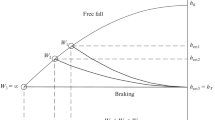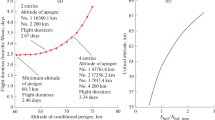Abstract
The problem of the transportation of the results of experiments and observations to Earth every so often appears in space research. Its simplest and low-cost solution is the employment of a small ballistic reentry spacecraft. Such a spacecraft has no system of control of the descent trajectory in the atmosphere. This can result in a large spread of landing points, which make it difficult to search for the spacecraft and very often a safe landing. In this work, a choice of a compromise scheme of the flight is considered, which includes the optimum braking maneuver, adequate conditions of the entry into the atmosphere with limited heating and overload, and also the possibility of landing within the limits of a circle with a radius of 12.5 km. The following disturbing factors were taken into account in the analysis of the accuracy of landing: the errors of the braking impulse execution, the variations of the atmosphere density and the wind, the error of the specification of the ballistic coefficient of the reentry spacecraft, and a displacement of its center of mass from the symmetry axis. It is demonstrated that the optimum maneuver assures the maximum absolute value of the reentry angle and the insensitivity of the trajectory of descent with respect to small errors of orientation of the braking engine in the plane of the orbit. It is also demonstrated that the possible error of the landing point due to the error of specification of the ballistic coefficient does not depend (in the linear approximation) upon its value and depends only upon the reentry angle and the accuracy of specification of this coefficient. A guided parachute with an aerodynamic efficiency of about two should be used at the last leg of the reentry trajectory. This will allow one to land in a prescribed range and to produce adequate conditions for the interception of the reentry spacecraft by a helicopter in order to prevent a rough landing.
Similar content being viewed by others
REFERENCES
Sikharulidze, Yu.G., Optimum Impulsive Deceleration at Reentry into the Atmosphere, Kosm. Issled., 1970, vol. 8, no. 2, pp. 201-205.
Korchagin, A.N., Kostochko, P.M., and Sikharulidze, Yu.G., Computational Model of Earth's Disturbed Atmosphere, Kosm. Issled., 1999, vol. 37, no. 3, pp. 267-275.
Sikharulidze, Y.G., Korchagin, A.N., and Morales, P., Jr., Analysis of Accuracy at Ballistic Reentry in the Earth Atmosphere, RBCM, Journal of the Brazilian Society of Mechanical Sciences, 1999, vol. 21, pp. 523-533.
Author information
Authors and Affiliations
Rights and permissions
About this article
Cite this article
Sikharulidze, Y.G., Korchagin, A.N. Analysis of the Accuracy of Ballistic Descent from a Circular Circumterrestrial Orbit. Cosmic Research 40, 68–80 (2002). https://doi.org/10.1023/A:1014204103196
Issue Date:
DOI: https://doi.org/10.1023/A:1014204103196




